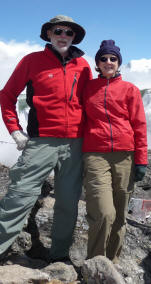
DAVE & MARSHA
MT. EVEREST REGION
WITH FRIENDS

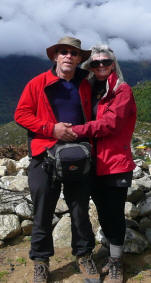
s STEVE & GAYLA
 DAVE & MARSHA |
TREKKING IN NEPAL MT. EVEREST REGION WITH FRIENDS
|
 s STEVE & GAYLA |
|
It was not clear why I was about to head back up into the Himalayas. Past experience had taught me that it could be a difficult trek. Perhaps it was because Steve has always been intrigued by my stories of climbing mountains, withstanding the cold and thin air of high altitudes. When our cruising friends Marsha and Dave discussed a trek in Nepal we were excited to join them as they are avid trekkers and like us not interested in a guided tour but one of independent trekking. We could not give up an opportunity to share this adventure. |
|
Dave and Marsha love Nepal. This is their 4th trek here, second time in the Everest region. They have chosen to fly into Phaplu at 7,900 foot elevation which was a wise choice. The airport in Lukla is further up at the 9,000 feet but it is on the well traveled Mt. Everest trekking route. By starting in Phaplu we have the advantage of fewer trekkers, a chance to experience the middle hills of the Himalayas in the Solo region and an opportunity to meet the Rai people who inhabit this area.
Waiting in the departure lounge of the Kathmandu domestic terminal was a bee hive of activity. Planes were delayed due to weather into both Phaplu and Lukla the two airstrips into the middle hills of the Himalayas. A bus can be taken from Kathmandu to Jiri but horror stories of a long arduous journey had us gladly paying the $100US each to take us further up, thus more time to trek. After a four hour delay we boarded the 14 seat Yeti Airline twin otter anticipating the 40 minute flight into Phaplu.
No one is especially excited about the flight, most of all Marsha. Steve on the other hand has a front row seat and is straining to see the instrument panel to relive his days as a private pilot. Just before take off the other passengers, Australians and French fill in the rest of the seats. A stewardess in traditional Tibetan long black skirt with colorful striped apron hurriedly makes her was down the narrow isle passing out candy and cotton for ear plugs. From my seat near the back I can see the runway out the window thru the open cockpit door and watch eagerly as the pilot grips the two adjacent handles above the cockpit. Within seconds we are lifting off, the side windows exposing the thick green curtain of valleys, the middle Himalayas.
There is not a whimper from any of the passengers,
everyone is stone silent and gripping tightly to the seats in front of
them, only the engines drown can be heard. The flight is smooth but for
passing into clouds, then barely descending we are banking left, the
wing tip coming precariously close to a ridge dotted with pine trees.
Suddenly Steve stands bolt upright. I am not sure if he is ready to
take over the controls or jump out. Our hearts are in our throats.
It is rather frightening to land so high up. |
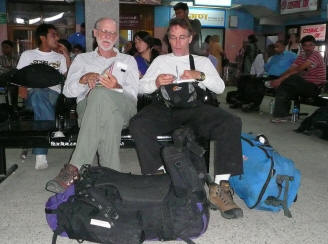 Dave and Steve patiently waiting
|
|
The town
is very clean with lots of flowers. There are about 20 buildings, a school and a small hospital donated by Sir Edmund
Hillary the first man to reach the summit of Mt. Everest in 1953. |
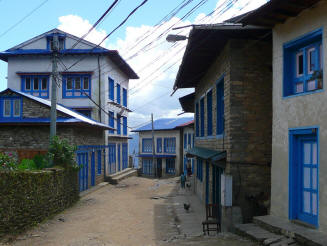 |
|
Phaplu |
|
Mt. Everest Guest House
|
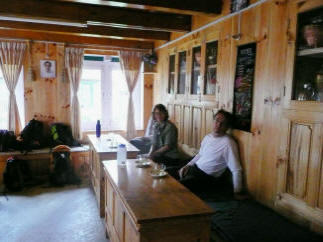 |
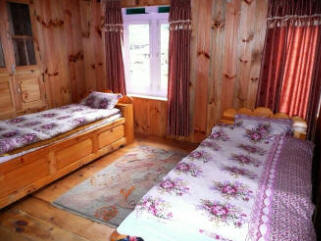 |
The gompa is set below the town surrounded by cultivated fields and pine
trees. It's bright orange roof and multicolored paned window
frames sets it apart from the surrounding fields. 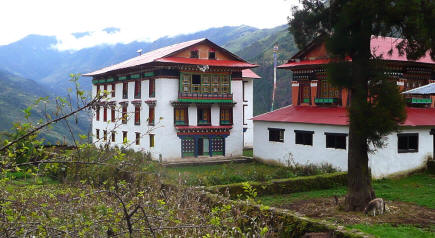 Passing through the small wooden main gate we can see the huge prayer wheel, over 6 feet tall, in a small room. It was once brightly colored now faded through the years. Short ropes hang from the bottom which you grab hold to spin the wheel propelling the enclosed prayers to the gods.
|
|
|
Sept. 29, 2009 Phaplu to Ringmo (7,900ft to 8,858ft.)
We begin our trek from 7,900 feet after a good nights sleep on simple wooden beds with thick foam mattresses snuggled up in our down sleeping bags high in the Himalayas. Our room cost 500rp which is about $7 US. We are awake at 5AM after a 6:30AM breakfast of banana pancakes, porridge with banana and chapattis, flat bread with honey, we are on our way by 7:30AM.
Outside the air is cool and clear with a spectacular view of snow covered mountain peaks. We adjust our walking poles and backpacks, the packs weighting about 25 pounds and waddle down the trail, across small wooden board bridges across deep mud past the gompa and into the forest. Then breaking out into the open we have magnificent views of huge green mountains, terraced and dotted with little white houses with blue or green tin roofs.
A few locals pass us carrying bundles in baskets on their backs with a strap over their head just behind the hairline and the other end supporting the basket.
Also, a convoy of donkey’s pass by carrying gas
bottles on wooden saddles. Each one has a huge metal bell dangling
from a collar around their necks alerting us with a gentle tinkling
sound that brings Marsha to a state of nostalgia. “This is
what brings me back to Nepal”.
It is the one prominent sound we will hear along with the young children passing by, hands raised in prayer fashion shyly uttering the words “Namaste”. (I salute the God within you) |
|
|
The rivers run south and are separated by high ridges so the route is a succession of ups and downs. The valleys are deep so the climbs and descents are very strenuous with mostly stone steps climbing upward to Ringmo. A young women passes me on a precariously steep and narrow step with a baby on her back and a young boy with a very large load strapped to his back wearing only rubber crock shoes.
I find it hard to keep a steady pace with the uneven heights of the stone steps, but I know the key in such rigorous trekking is to keep moving at a slow steady pace. Steve and Dave have both taken a tumble, only just a drop to a knee, unbalanced with a heavy pack and always on the downward trail. Marsha keeps a good pace while I prefer to lay back concentrating on each step and begin to feel like the pack animals passing me by. Fortunately there are rock walls with stone or wood benches to rest along the way.
|
|
|
We also pass our first Mani walls, to which with
respect, we must always pass to the left keeping the wall on our right. These are long stone walls
inlaid with Buddhist prayer slates. Most of the villages we pass are
inhabited by Rai or Sherpa people. Sherpa’s are more prevalent
further up and are famous as guides or porters. Near Ringmo it begins to rain and
sherpas begin to pass us with huge loads
protected with umbrellas. 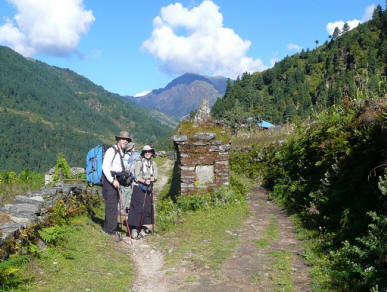 |
|
 |
|
It took 5 hours to reach Ringmo at 8,858 feet. Steve comments that he is totally ‘knackered’ to which ensues a response that he should be ‘yackered’ as it is the female yak that is called a Nak.
We check into the Yak and Nak Apple House Lodge. These lower areas of the Solo region are known for their apple orchards. At the village of Ringmo the trail also meets up with the Jiri track had we come in by bus.
The small rooms are all wood, very clean with views once again of snow covered peaks. Here we pay only 190 rupees but a snickers bar sold here is 200 rupees, 10 rupees more than our room. As we pass by the kitchen, up steeper and higher steps than we have seen all day, I peer into this dark and smoky room with a bench seat below a front window and a table more like a desk. A big clay oven is in the middle of the room with two cats on a mat sleeping on top next to a boiling kettle. An older women in traditional Tibetan dress with long striped apron is moving about tending the kettle for our much needed shower. But, here a boiler on the back wall used for washing in the kitchen is also used for our showers and washing clothes. We each do our own laundry, Steve reluctant to stoop to the small basin in the crude little room but I explain how necessary it is to keep up with clean clothes as we are carrying only three pair of socks and a couple changes of clothing. |
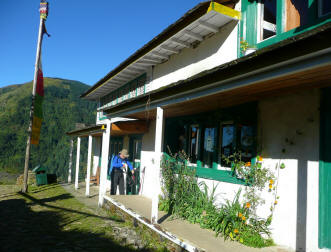 Yak and Nak Apple House Lodge
|
|
While we finish our cups of black tea which is cheapest on the menu at 30 rupees the men fill up our two wide mouth water bottles each, add an iodine tablet to be pumped and filtered in one third an hour with our small hand held Katadine pumps. While clean mountain streams abound there is still the chance of Girardia and other bacteria our delicate systems are not used to. In Kathmandu they even recommend not even brushing your teeth in the water. |
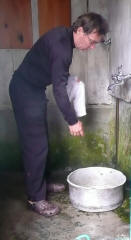 Laundry time |
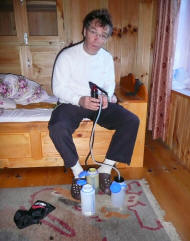 Filtering water |
|
Sept. 30 Ringmo to Jubing (8858ft. to
5577ft.) It is a rough day but probably due to the fact it is only our second day or perhaps because the trail climbed up 3000 feet then dropped 2000 feet. The descending is sometimes more difficult than the climb. The 3000 foot ascent took us up past an old gompa then to the Trackshindo La (La meaning pass) at 10,075 feet dividing the Solo and Sherpa areas. Views of the snow covered Karyalung peaks were breathtaking. We stopped for tea at the top just before the Kani, an entrance arch with a row of prayer wheels on either side of the interior walls.
|
|
|
The Chhodar or vertical prayer flags on 8-10m poles and the Lungdar or wild horse flags (prayer flags) with religious prayers and mantras are flopping in the wind hoping to be rubbed off by wind or water and carried to all sentient beings. |
|
| Half hour down we arrive at Trakshindo (9,612 feet). The gompa here
was established by the Tengboche Lama in 1996. From here we could see
the Sherpa village of Nuntala/Manidingma (7,710ft) across the terraced
fields and tea bushes. From Nunthala there is a steep decent where
at one place the trail was wiped out completely by a landslide. We
had to tip toe precariously over wet stones and slippery mud then climb
down over the rubble. It was on this steep decent that Marsha
twisted her ankle and I realized my shoe has come untied and I felt a blister coming
on.
|
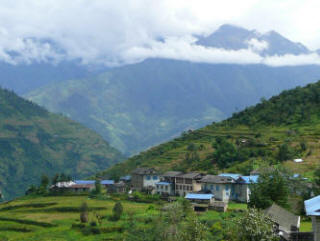 Trakshindo
|
| But the day proved to have good weather and the scenery even more spectacular the lower we dropped. There were fields of potatoes, wheat, bean, barley and buckwheat. Further on corn was being harvested and drying in vertical racks. The older houses are made of stone with mud and straw in-between the hand chiseled blocks, and small rectangular windows highlighted in paint. In front of some housed bright red Dailies were blooming. |
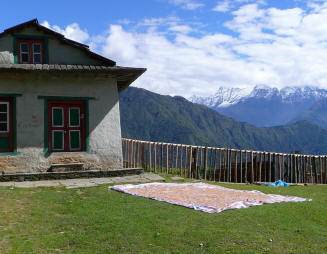 Local house /drying beans |
|
|
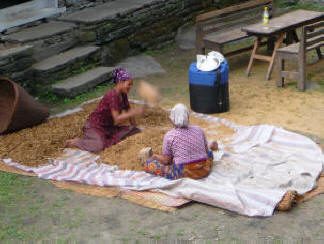 Local Rai women sorting beans |
| A young baby was sitting out on a wooden bench with a bowl of rice in
front of him, his bare bottom and face smeared with rice as he ate
contently away despite the two strange ladies snapping photos. Then just around a bend there was an older women toughened from the years bent over digging in the earth while a similar weather worn man guided 2 wooden yoked oxen down a furl with a wood plow. |
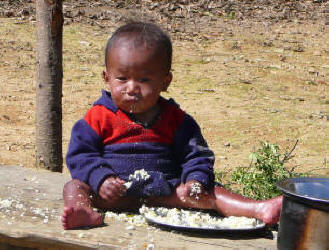 Lunch time of rice |
| But what is truly mind boggling is the last two years some of the people passing us on the trail have radios and cell phones. We have seen newer buildings with tin roofs, solar panels and ovens next to pit toilets, gravity fed water, fires for heating in steel barrels with tin can pipes, a mixture of new technology and primitive living conditions. |
|
After hours of steep descents, crossing
gullies and little streams we cross a covered bridge and then a 109m
long suspension bridge over the Dudhi Koshi river.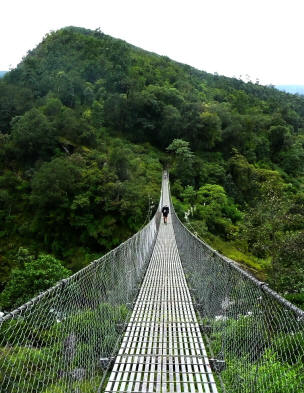 This bridge was built by the Swiss for their expedition to Mt. Everest in 1952. After then they set up an organization responsible for building many more bridges across the country. The last half hour was hard for me as my pack seemed to get heavier,
breathing more labored and the stone steps even steeper. I prefer being at the back where I can
concentrate on my slow steady pace which quite suits me and thus I have
retained the name ‘half track’. |
|
|
The main point of Buddhist practice is to always scrutinize and improve yourself. The teachings should be applied to make one gentler, more peaceful, loving and compassionate and especially to know that all things are relative and impermanent which is helpful when we are faced with difficulties. |
|
This was our third day and a good one with fine warm weather but Steve and Marsha were extremely sore in the calf muscles. I had no trouble dragging myself out of my warm sleeping bag in the middle of the night, navigating the dark steep steps to make my way outside and across the cold stone path to the outdoor squat toilet. Once there I did find a few sore thigh muscles preventing any long term stay. Besides the cold night air was penetrating. I made my way back up the steep stairway at a faster pace then I’d had all day. I had also opted for a spit bath before bed in a crude dark cold room using a thermos of hot water. I found my old trekking trick of dousing myself with baby powder was almost more efficient and certainly more tolerable.
We stick to the local food of potatoes, yak cheese
and mountain vegetables, and the old stand by Dahl Baht. After
dinner we then order breakfast for a 6:30PM serving. We usually
all order the same, a
big bowl of porridge with apple and find it very sufficient till the
next tea house. Steve tried the Tibetan bread which is much like Indian
fry bread. The glass front wooden cabinets were full of chocolate
bars, Pringle potato chips, Coke, biscuits and whisky. We all opted
out of trying the Snickers pie, Twix pie and Mars Bar pie.
|
|
|
|
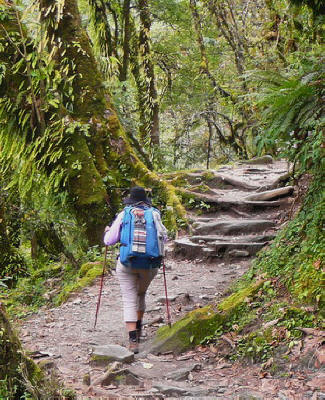 Trail to Kharakkola through fern forest |
|
From here we could see Kharikhola (6726ft) spread out before us and the terraced verdant green mullet fields we must pass through. Somewhere along here Steve had his first experience with a leech. Leeches abound during monsoon in this area. I quickly stretched out it’s body and with the quick flick of a Bic lighter, it let go leaving a big sucker bite on his lower back.
Reaching Kharikohla we met up with Marsha and Dave
who opted to continue on, Dave mentioning the possibility of afternoon
rain. Steve and I decided a good substantial lunch was in order to get us up the
final steep climb to Bupsa. |
|
|
We spent the next 2 hours going up a steep incline
but this time more mud, not rock and I was able to move more quickly
still keeping my heart beat steady. I made the mistake of chugging down
a small Snickers bar and soon was having a sugar crash and literally got
stuck on the side of a terraced field. Fortunately it didn’t send my
heart aflutter as chocolate sometimes does. Three little boys sat
transfixed on this white haired lady flopped out in their field.
It is hot and Steve was getting uncomfortable and bitchy but it was only this AM he told me that no other woman would do this with him. Then later he comments how rough I must have had it climbing Mt. Kilimanjaro. Hopefully he will never harass me again when times get tough. I have already experienced the thin air in high altitudes, which he has not, so I am beginning to wonder if my pace will slow everyone down. The one factor I learned on that climb was to take a slow steady pace. |
Mud trail
|
|
The word Buddha means ‘one who is awake’. It is the experience of awakening to the truth of life that is offered in the Buddhist tradition. He saw that human freedom must come from practicing a life of inner and outer balance and he called this discovery the ‘Middle Path’. |
|
|
|
Bupsa is at an elevation of 7,710feet not yet into the higher altitudes but drinking copious amounts of water is necessary and will be mandatory further up to flush the build up of carbonates from the kidneys that contribute to altitude sickness. AMS (acute mountain sickness) is possible above 10,000 feet and ¾ of all climbers will have at least mild symptoms.
There are no specific factors such as age, gender or physical condition that determines who will get it. One of the symptoms of dehydration is no matter how much liquid you put in more comes out.
We arrive in Bupsa to a nice room at the Yellow Top
Lodge with great views set up by Marsha and Dave. We are feeling a bit
guilty that our friends arrive ahead and end up getting us our room. We
are so grateful but feel they might be feeling a bit too much like
guides. We asked them if we could discuss the itinerary they have
worked out. This will give us a better idea mentally to help set our pace. Hopefully
it will take off some of the
pressure of always pushing along. We did arrive at Bupsa by 2PM so this day was encouraging. We all took hot showers and did our laundry and hung it out to dry. Steve is still grumbling about doing his but perhaps it is because he seems to be coming down with a cold. Dave had a cold in Kathmandu so Marsha and I rationalize it is a germ for men only and we are safe.
The lodges kitchen dining area is very nice and the
menu varied. We break out the game of Pegs and Jokers of which
each of us is carrying a quarter of the wood frame game board.
After all it is only fair we each carry our share but we never dare ask
Dave for a piece of his chocolate, the 1 pound Trader Joe special that he
alone is carrying. |
|
|
Our fourth day we set off at 7:15AM after our usual
breakfast of hot porridge. Steve slept well after a dose of TheraFlu
medication and again we feel very optimistic. We all think we can make
it to Surke but the next valley has to be traversed and we may get
separated.
After a contour climb and past a huge rock we can see the town of Puiyan (9,121ft) but the distance is deceiving as we still must decend 1000 feet, cross a tributary on a steel bridge before entering Puiyan, 3 hours after leaving Bupsa.
We meet up with Dave and Marsha who have just
arrived and are visiting with a nice Indian couple Airman and Ram. They
are slightly younger but with graying hair. We all commiserate about us
aging trekkers doing this stretch where few younger trekkers venture
choosing to fly in to Lukla further up and start there.
It is still another 3 ½ to 4 hours to Surke so Marsha and Dave set off with our assurance we will make it just fine. |
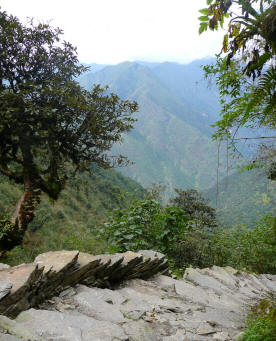 Steep descents/steeper ascents 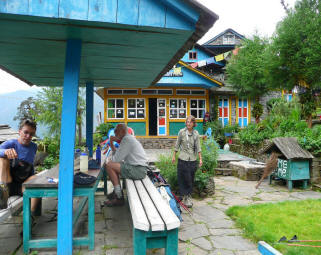 Lunch in Puiyan |
|
After eating we pass a small festival blessing a
new Mani wall. The local lama is presiding over the ceremony. Many
colorful and delicious looking dishes are set out mostly with sliced
apple and below elaborate decorations made of yak butter.
The perpendicular sides of the valley from here are so steep the trail zig zags upward almost vertically and traverses across the face of the mountain on a narrow trail. It is slow going with huge rocks on the trail.
|
|
|
O Mani Padme Hum’ is the prayer or mantra that Buddhists say out loud to themselves invoking the blessings of Chenrezing the Tibetan name for Buddha of Compassion. |
|
|
|
I point out some beautiful waterfalls across the valley and once on
our way the sacred mountain of Khumbila comes into view as does the
village of Surke. (7,546 ft) I try to keep Steve
focused on reaching our destination. We arrive at Surke at the Yak and Yeti Lodge for
the night after a rigorous and strenuous 9 hour day. O Mani Padme Hum.
Oct. 3,2009 Surke to Padking (7546ft. to 9121ft.)
The name Surke in Tibetan is Bua which means
‘damp’. True there is not much sun here between the valleys but we are
witness to the spectacular Kongde ridge that is the massive mountain
rising up from the Bhote Koshi river in front of the village of Namche. |
|
|
It was a bad day that ended well. Upon rising Steve discovers a tick, it’s head embedded in his thigh. He is anxiously trying to eradicate it’s body while trying to keep it’s head from separating. I immediately respond trying to reassure him but I really don’t do well with ticks before tea. Everyone is still asleep so I try the flick of the Bic trick but before it retracts completely and with our impatient and anxiousness the flame causes the tick to explode leaving part of the head in his thigh. I apply antiseptic and a band aid and vowed to check in at the first aid station. Later we discover a Dutchman next door, one of the few trekkers we have encountered, had a device for removing ticks. Dave remembers that applying Vaseline may have in time caused it to suffocate. Too late the little half tick will have to trek along with him to Lukla.
There is a light rain and the steep wet stone climb ahead is daunting. We must take the direct steep route to Lukla to find a doctor and change our tickets. We have decided to fly out of Lukla on our return rather than retrace our steps back to Phaplu which will give us extra days in the high altitudes.
Unfortunately we could have saved ourselves by
bypassing Lukla going straight to Namche on an easier trail but it is
not to be. We must climb up almost 2000 feet to reach Lukla. About
half way up the Dutchman, a fit 45 year old with a sherpa porter and a
guide come up behind me. I stop for a breath and as they pass by I
joke “how is it that you have two and I have none?”. His dark
skinned Caucasian looking porter says in good English, “You should
have a porter.” Immediately he shifts his load and insists he let me carry my
pack. I am grateful but decline but his words were more like it would
be me doing him a favor to carry my pack. The Dutchman is fine with it
so off they go, Ram the name of the polite porter calls back that he
will leave my pack at the Khumbu Resort in Lukla where I can find it
when I arrive. |
|
|
Steve and I begin the climb once again, this time I
am able to keep a better pace with Steve. Suddenly I am enthusiastic
about my surroundings and not plodding along looking at my feet. I am
thrilled.
Chhiring's contagious smile and easy manner made us feel he was genuinely enjoying our conversation and eager to be of assistance. He escorted us to the Swiss Hospital high up on a hill (of course) overlooking Lukla. It was closed for a holiday. Knowing Steve was anxious to get the tick out, Chhiring jumped the front gate and found a doctor. The next hour was spent digging and prodding but also getting to know the doctor and her assistant. The Nepalese doctor Dr. Pasang Lhamu was trained in the Ukraine and is now the physician of the Swiss Hospital in Lukla.
We had met up with Marsha and Dave who had already changed our tickets and were anxious to get up to Namche while the weather held. But not before Marsha had her treat…a big hot cinnamon roll!
When I retrieved my pack at the Khumbu Resort I tried to give Ram a tip. He flatly refused explaining, “I wanted to help you”. I was so touched, then explained to Chhiring to please explain I too wanted to give to him…a bonus. To this Ram accepted.
So now we have met those amazing people of all sects and caste systems who keep the trekking industry going. Steve has decided to hire Chhiring and commissions him to carry my pack on to Namche.
Chhiring scurries around town gathering his gear as
now an employed sherpa. He explains later that he prayed all the way up
from Surke to find a trekker. If he can find three during the season,
it will support his family for an entire year. He has settled on the
price of 800 rupees ($10US) a day paying his own food and lodging.
These figures never cease to amaze us as others have hired through
agencies at $2000US for 2 weeks. We started off on our own and have
been blessed to find Chhring. He is prompt, caring and even shows Steve
a new way to tie his hiking boots then proceeds to tie them for him. From Lukla, Steve , Chhiring and myself say good-bye to Chhiring's lovely wife Dayangi and head upward once again. From Lukla there are many trekkers who have just flown in and with porters, yak and zopkio (crossbreed between yak and cow) carrying bulging trekking gear strapped to wooden saddles all vying for space on the narrow steep trail.
|
|
|
It is a busy highway with dozens of trekkers
which is a bit disappointing after the our solitude on the lower
trails. There are also porters carrying 5
sheets of ¾ ply wood on their backs, expedition porters carrying huge
water proof North Face bags some three to a porter. We saw one
with 5 cases of beer, cases of coke, and 4 – 5 liter plastic jugs of
cooking fuel.
Chuplung (8,727ft) is where the trail meets the main
trail from Jiri and Salpa-Arun. More trekkers join the fray. During
the months of Oct. to mid Nov. the trails are known to be clogged with
bottlenecks of yak and zopkio convoys especially crossing bridges and
they have our respect too, so we always move to the side to wait. If on
the trail we move to the upside as they pass as many areas are steep
drops down and these animals can be very determined. We love sharing
the trail with them as the tinkling bells around their necks are music
to our ears. One of the most deserted and partially uninhabited trails is from Phaplu to Chuplung so we are also most grateful that Marsha and Dave chose this way. They have gone on ahead but we now have Chhiring to guide us and enjoy his first hand explanations of the area. Local knowledge is always interesting as it unfolds as we go. |
5 cases of beer |
It is hard not to feel elated in this sharp
mountain air with bright sunlight warming the day Then there is the
Thado Kosi with it’s elegant bridges crossing the Kusum Khola prayer
flags flapping in the wind off the bridge. And then comes the village
of Ghat a little settlement with a gompa at the end of town.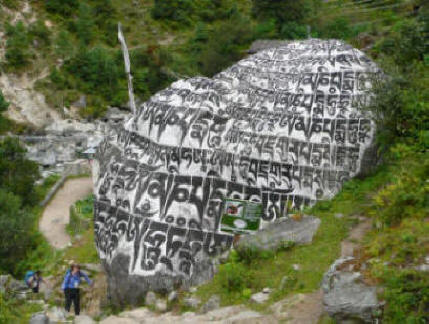 We pass many Phenpu or huge rocks with prayers engraved. These are from the followers of ancient Bon belief who worship spirits of land, water, trees, mountains, and other natural elements. 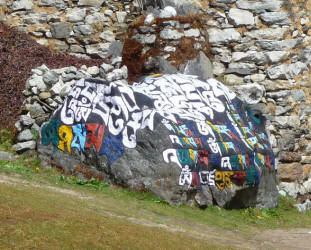
|
|
|
Finally after several hours we come to Padking –
lodge city. We check in to Trekkers Holiday Inn Guest House, get a
private room and bath for 600 rupees. Chhiring knows the owners and gets
to chop wood to cook the meals for his keep. There are many trekkers
here and we meet many just starting their trekking. We learn that
individual trekkers like ourselves are in the minority.
Oct 4,2009 Padking to Namche (9121ft.
to 11,319) |
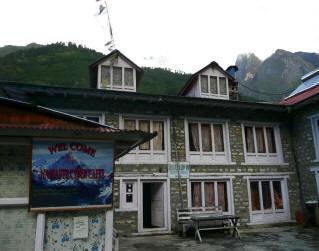 Padking/Trekkers Holiday Inn Guest House |
|
The sun came out and it was a beautiful day with flatter areas, along the river, less rocky and many tea houses. Again we cross one of the well constructed steel cable suspension bridges built by the Swiss this one in 1999 and wide enough for entire yak trains.
The views
become more spectacular after the village of Tok Tok as the sheer face
of Thamserku comes into view. Beautiful small tea houses, shops
and lodges take amazingly beautiful spots next to waterfalls. |
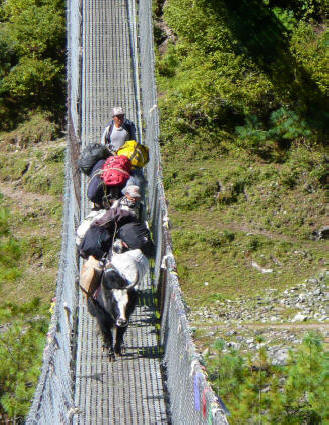 Sharing bridges and trail with Yak trains |
| We pass yak dung drying on stone walls used to
cook our meals over and stone smoke houses.
|
|
|
Monjo 9,235 feet is a small gathering area for the entrance to the Sagarmatha National Park. Here we show our TIMS card (trekking permit) we acquired in Kathmandu for 500 rupees and pay a park fee of 1000 rupees. |
|
| Sagarmatha National Park Entrance |
|
We are now truly and officially in the Khumbu region leaving Solo behind. We meet up with Marsha and Dave just as a yak train crosses the bridge pushing us all back into a space with a porter carrying wood the size of a very substantial door.
|
|
|
The walls here are so steep we must zig zag along
the ridge at the Bhote Koshi circumventing the impenetrable gorge
entrance to the Everest Gokyo valley. Each step is a deliberate effort
requiring a pause to catch our breath. We check in at a police check
post pass under a Kani and shortly after Namche unfolds in front of us. NAMCHE BAZAR - 11,319ft.
|
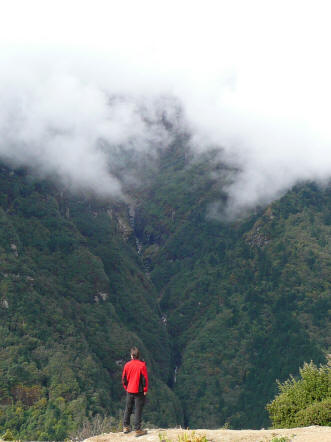 Steve across from Kondge mountain |
| Namche is a small village on the side of a
hill facing the great black face of Kondge high above the Bhote Koshi
river with a population of around 2000.
The village is a colorful mix of local handicrafts and modern day trekking equipment, knock off clothing, and hand woven fabrics, western food, bakeries and traditional food. There are no motorized vehicles, only yak or animal trains which share the stone walkways with the locals, trekkers and porters. |
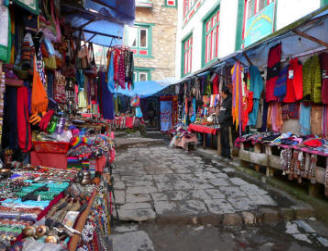 Narrow Namche street/no motorized vehicles |
|
|
 |
|
The local school playground Cinnamon rolls, apple pies, pizza |
 |
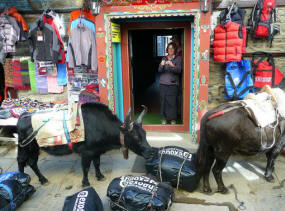 |
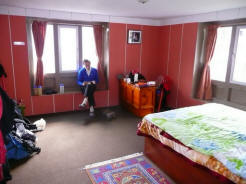 |
|
$2 a night room Marsha in doorway of our Khumbu Lodge $15 a night room |
| Every Saturday there is a traditional market and on Sunday a Tibetan
market where they come from miles over the high mountain passes to sell
there wares.
|
|
Namche is also the staging point for trekkers going
further up into valleys around Mt. Everest or to the Mt. Everest Base
camp. There are many options for further trekking and several loop
trails. It is one of the first stopping places to acclimatize for
the higher elevations to prevent altitude sickness and prepare for the
colder bleaker environment.  Expedition camp site above Namche |
|
| The first attempts on Everest were from the north in
Tibet. The Dalai Lama eventually granted permission in 1921 and
the first 7 unsuccessful attempts were from Tibet. In 1950,
Everest expeditions became prohibited from Tibet, but the Kingdom of
Nepal started to grant entry to foreign expeditions. Edmond Hillary and his sherpa Tenzing Norkay were the first ever to reached the summit of Mt. Everest on the 29th of May 1953, via the route from the South Col. |
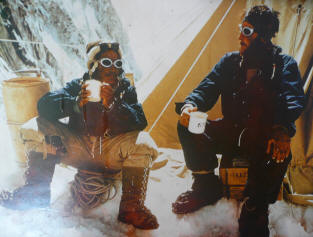 Sherpa Tenzing and Edmond Hillary 1953 |
| Since then, overall more than 1,000
climbers from over 20 countries have climbed to the summit by various
routes from both north and south. Their ages have ranged from 13
years to sixty. At least 100 people have perished, most commonly
by avalanches, falls in crevasses, cold or the effects of the thin air
and extremely high altitudes.
Over a dozen women have made their mark in the history of climbing to the summit of Mt. Everest |
|
| Women climbers of Mt. Everest |
|
Marsha, Dave and Steve have decided to continue
on a loop trail for another week up the Gokyo Valley which follows the
Dadhi Koshi river one pass away from the Mt. Everest Base Camp.
From there they will cross over the Renjo La pass returning to Namche via Thame. |
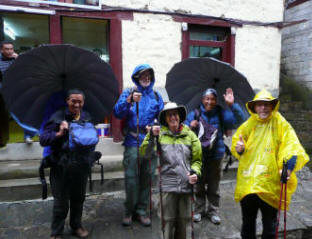 |
| Leaving for Gokyo Valley Loop | |
|
I have decided to remain in Namche to await their return.
Had I continued on I would have not had a fair assessment of this world
around me. I realized it is what I longed for, to be free for a time from the schedules, time frames and expectations. With each day I realized I wanted this time on my own, to re-establish my sense of independence, to let go, meditate and revive. An opportunity for renewal.
|
|
| Sacred sites and prayer wheels |
| Years ago I reached the top of Mt. Kilimanjaro, Africa's highest mountain at 19,341 ft. The Renjo Pass was not as high but once I realized I could make it I had no desire to continue on and climb another mountain or cross another pass knowing the succession of days ahead in the cold at high altitude. Instead I could watch, listen, feel and think. I wanted to savor the day, going no where doing nothing here in the Himalayas. There was no destination, no end, no purpose. The way was my journey. |
|
|
Buddhism promises nothing. It teaches us to be what we are where we are, constantly. In the 6th point in the Eight Fold Path of the Buddhist tradition is 'Right Effort'. There is no need to be continually just pushing along, drudging along. If you are awake and open in living situations it is possible for them and you to be creative, beautiful, humorous and delightful. 'The Myth of Freedom by Chogyam Trunpa' |
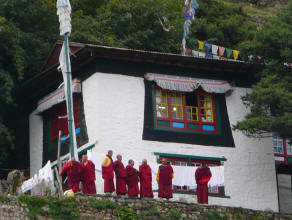 CLICK HERE |
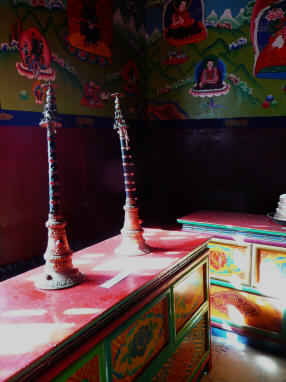 Zong Doong Horns |
 Prayer wheels 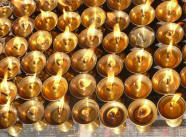 Yak butter lamps |
|
I wake every morning to the tinkling yak bells, the smell of inscents and the buzzing sound of the Zong Doong, horns from the monastery above. I hear the Thung shell trumpet calling the monks to prayer and see them gliding along the stone pathway in their saffron and ochre robes on their way to enlightenment. I have seen the Tibetans arrive over high mountain passes with yak loaded with wares to sell at the market. I sat beside the glowing flickering butter lamps before the lama observing a blessing ceremony presenting the Kata scarves for good luck and safe journey. I am renewed. |
|
Namche Bazar Oct.9,2009
The clouds have cleared. It is freezing cold but
sunny and clear. As I climb alone on the steep stone steps above Namche
I was greeted by a trekker coming down. “The mountain awaits you.”
|
|
|
|
|
The panorama of mountains over 20,000 feet captures me. Ama Dablem with it’s steep jagged peak covered in snow and then the sun rises up over Themsurku and magnificent waterfalls cascade down it’s face. The jagged range to the right, Kasumkhanguru and beyond and below the valley we ascended from is now filled with clouds. Kondge, directly in front of Namche rises up as does Tengirangitahu behind the monastery. Then the sacred mountain of Khumbila which no one is allowed to climb, Tawoche, then Nupse, Lhotse and back to Mt. Everest.
The sun rises higher and beats down on my face. It is warm and soothing in this harsh environment. I sit transfixed for hours. |
The Kasumkhanguru Range |
|
Longchempse, a peerless master of the deepest teachings of Tibetan Buddhism- Dgogchen or ‘The Great Perfection’ explained: ‘High among the mountains, mind grows clear and expansive. Perfect as the place to bring freshness when dull, or to practice visualizations. Snow clad regions make meditation limpid, awareness bright and lucid. Ideal for cultivating insight and where impediments are few’. |
|
|
|
Dave, Marsha and Steve continuing up the Gokyo Valley about 1000ft (300m) elevation a day stopping in Dole and Machherma |
|
|
|
Village of Gokyo 15,584ft. below on the banks of Gokyo Lake from Gokyo Ri |
|
|
|
Gokyo Ri 17,575 on top of the peak Steve in front of Mt. Everest |
|
|
|
Resting en route to Renjo La in front of Mt. Everest and Lhotse |
|
|
|
Chhiring and Babu eating cheese to celebrate reaching Renjo La then climb the boulders to place the prayer flags |
|
|
| View from Renjo La of Mt. Everest 29,029ft. (8,848m) highest mountain in the world |
|
|
|
Steve reaches his greatest height of 17,772ft. (5,430m) crossing the Renjo La |
|
|
|
We each found our place high in the Himalayas. Marsha and
Dave discovered spending more time in the middle Himalayas gave them a
better appreciation of the people and culture. Having Babu
and Chhring as porters for the higher altitude climb was a new
experience for them, one they may consider again in the future.
But most of all this was Steve's time, his first to stand high, as he
found that sense of personal accomplishment in reaching heights he had
never imagined |